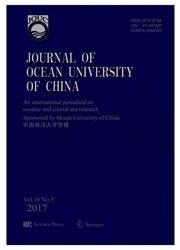

 中文摘要:
中文摘要:
Three-stranded rope is widely used in fishing gear and mooring system. Results of numerical simulation are presented for flow around a three-stranded rope in uniform flow. The simulation was carried out to study the hydrodynamic characteristics of pressure and velocity fields of steady incompressible laminar and turbulent wakes behind a three-stranded rope. A three-cylinder configuration and single circular cylinder configuration are used to model the three-stranded rope in the two-dimensional simulation. The governing equations, Navier-Stokes equations, are solved by using two-dimensional finite volume method. The turbulence flow is simulated using Standard κ-ε model and Shear-Stress Transport κ-ω(SST) model. The drag of the three-cylinder model and single cylinder model is calculated for different Reynolds numbers by using control volume analysis method. The pressure coefficient is also calculated for the turbulent model and laminar model based on the control surface method. From the comparison of the drag coefficient and the pressure of the single cylinder and three-cylinder models, it is found that the drag coefficients of the three-cylinder model are generally 1.3–1.5 times those of the single circular cylinder for different Reynolds numbers. Comparing the numerical results with water tank test data, the results of the three-cylinder model are closer to the experiment results than the single cylinder model results.
 英文摘要:
英文摘要:
Three-stranded rope is widely used in fishing gear and mooring system. Results of numerical simulation are presented for flow around a three-stranded rope in uniform flow. The simulation was carried out to study the hydrodynamic characteristics of pressure and velocity fields of steady incompressible laminar and turbulent wakes behind a three-stranded rope. A three-cylinder configuration and single circular cylinder configuration are used to model the three-stranded rope in the two-dimensional simulation. The governing equations, Navier-Stokes equations, are solved by using two-dimensional finite volume method. The turbulence flow is simulated using Standard κ-ε model and Shear-Stress Transport κ-ω(SST) model. The drag of the three-cylinder model and single cylinder model is calculated for different Reynolds numbers by using control volume analysis method. The pressure coefficient is also calculated for the turbulent model and laminar model based on the control surface method. From the comparison of the drag coefficient and the pressure of the single cylinder and three-cylinder models, it is found that the drag coefficients of the three-cylinder model are generally 1.3–1.5 times those of the single circular cylinder for different Reynolds numbers. Comparing the numerical results with water tank test data, the results of the three-cylinder model are closer to the experiment results than the single cylinder model results.
 同期刊论文项目
同期刊论文项目
 同项目期刊论文
同项目期刊论文
 Experimental investigationan danalysis of hydrodynamic characteristics of a net panel oscillating in
Experimental investigationan danalysis of hydrodynamic characteristics of a net panel oscillating in Experimental investigation and analysis of hydrodynamic characteristics of a net panel oscillating i
Experimental investigation and analysis of hydrodynamic characteristics of a net panel oscillating i 期刊信息
期刊信息
